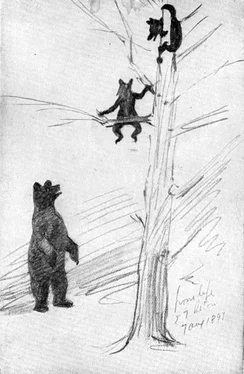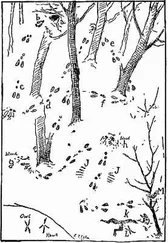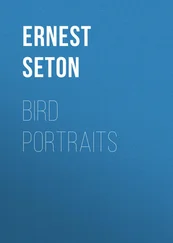Ernest Seton - Wild Animals at Home
Здесь есть возможность читать онлайн «Ernest Seton - Wild Animals at Home» весь текст электронной книги совершенно бесплатно (целиком полную версию без сокращений). В некоторых случаях можно слушать аудио, скачать через торрент в формате fb2 и присутствует краткое содержание. Год выпуска: 2009, Жанр: Природа и животные, на английском языке. Описание произведения, (предисловие) а так же отзывы посетителей доступны на портале библиотеки ЛибКат.
- Название:Wild Animals at Home
- Автор:
- Жанр:
- Год:2009
- ISBN:нет данных
- Рейтинг книги:5 / 5. Голосов: 1
-
Избранное:Добавить в избранное
- Отзывы:
-
Ваша оценка:
- 100
- 1
- 2
- 3
- 4
- 5
Wild Animals at Home: краткое содержание, описание и аннотация
Предлагаем к чтению аннотацию, описание, краткое содержание или предисловие (зависит от того, что написал сам автор книги «Wild Animals at Home»). Если вы не нашли необходимую информацию о книге — напишите в комментариях, мы постараемся отыскать её.
Wild Animals at Home — читать онлайн бесплатно полную книгу (весь текст) целиком
Ниже представлен текст книги, разбитый по страницам. Система сохранения места последней прочитанной страницы, позволяет с удобством читать онлайн бесплатно книгу «Wild Animals at Home», без необходимости каждый раз заново искать на чём Вы остановились. Поставьте закладку, и сможете в любой момент перейти на страницу, на которой закончили чтение.
Интервал:
Закладка:
When the far-off squirrel ancestor of Yek-yek took to the plains for a range, another of the family selected the rocky hills.
He developed bigger claws for the harder digging, redder colour for the red-orange surroundings, and a far louder and longer cry for signalling across the peaks and canyons, and so became the bigger, handsomer, more important creature we call the Mountain Whistler, Yellow Marmot or Orange Woodchuck.
In all of the rugged mountain parts of the Yellowstone one may hear his peculiar, shrill whistle, especially in the warm mornings.

You carefully locate the direction of the note and proceed to climb toward it. You may have an hour's hard work before you sight the orange-breasted Whistler among the tumbled mass of rocks that surround his home, for it is a far-reaching sound, heard half a mile away at times.
Those who know the Groundhog of the East would recognize in the Rock Woodchuck its Western cousin, a little bigger, yellower, and brighter in its colours, living in the rocks and blessed with a whistle that would fill a small boy with envy. Now, lest the critical should object to the combination name of "Rock Woodchuck," it is well to remind them that "Woodchuck" has nothing to do with either "wood" or "chucking," but is our corrupted form of an Indian name "Ot-choeck," which is sometimes written also "We-jack."
In the ridge of broken rocks just back of Yancey's is a colony of the Whistlers; and there as I sat sketching one day, with my camera at hand, one poked his head up near me and gave me the pose that is seen in the photograph.
THE PACK-RAT AND HIS MUSEUM
Among my school fellows was a boy named Waddy who had a mania for collecting odds, ends, curios, bits of brass or china, shiny things, pebbles, fungus, old prints, bones, business cards, carved peach stones, twisted roots, distorted marbles, or freak buttons. Anything odd or glittering was his especial joy. He had no theory about these things. He did not do anything in particular with them. He found gratification in spreading them out to gloat over, but I think his chief joy was in the collecting. And when some comrade was found possessed of a novelty that stirred his cupidity, the pleasure of planning a campaign to secure possession, the working out of the details, and the glory of success, were more to Waddy than any other form of riches or exploit.
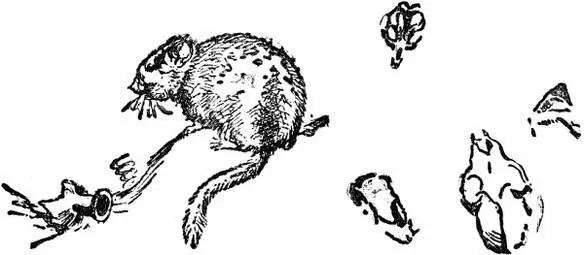
The Pack-rat is the Waddy of the mountains, or Waddy was the Pack-rat of the school. Imagine, if you would picture the Pack-rat, a small creature like a common rat, but with soft fur, a bushy tail, and soulful eyes, living the life of an ordinary rat in the woods, except that it has an extraordinary mania for collecting curios.
There can be little doubt that this began in the nest-building idea, and then, because it was necessary to protect his home, cactus leaves and thorny branches were piled on it. The instinct grew until to-day the nest of a Pack-rat is a mass of rubbish from one to four feet high, and four to eight feet across. I have examined many of these collections. They are usually around the trunks in a clump of low trees, and consist of a small central nest about eight inches across, warm and soft, with a great mass of sticks and thorns around and over this, leaving a narrow entrance well-guarded by an array of cactus spines; then on top of all, a most wonderful collection of pine cones, shells, pebbles, bones, scraps of paper and tin, and the skulls of other animals. And when the owner can add to these works of art or vertu a brass cartridge, a buckle or a copper rivet, his little bosom is doubtless filled with the same high joy that any great collector might feel on securing a Raphael or a Rembrandt.
I remember finding an old pipe in one Rat museum. Pistol cartridges are eagerly sought after, so are saddle buckles, even if he has to cut them surreptitiously from the saddle of some camper. And when any of these articles are found missing it is usual to seek out the nearest Rat house, and here commonly the stolen goods are discovered shamelessly exposed on top. I remember hearing of a set of false teeth that were lost in camp, but rescued in this very way.
A FREE TRADER
"Pack" is a Western word meaning "carry," and thus the Rat that carries off things is the "Pack-rat." But it has another peculiarity. As though it had a conscience disturbed by pilfering the treasure of another, it often brings back what may be considered a fair exchange. Thus a silver-plated spoon may have gone from its associate cup one night, but in that cup you may find a long pine cone or a surplus nail, by which token you may know that a Pack-rat has called and collected. Sometimes this enthusiastic fancier goes off with food, but leaves something in its place; in one case that I heard of, the Rat, either with a sense of humour or a mistaken idea of food values, after having carried off the camp biscuit, had filled the vacant dish with the round pellets known as "Elk sign." But evidently there is a disposition to deal fair; not to steal, but to trade. For this reason the creature is widely known as the "Trade Rat."
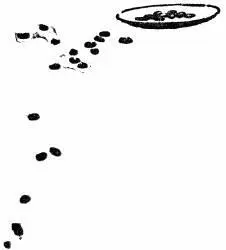
Although I have known the Pack-rat for years in the mountains, I never saw one within the strict lines of the Yellowstone sanctuary. But the guides all assure me that they are found and manifest the same disposition here as elsewhere. So that if you should lose sundry bright things around camp, or some morning find your boots stuffed with pebbles, deer sign, or thorns, do not turn peevish or charge the guide with folly; it means, simply, you have been visited by a Mountain Rat, and any un eatables you miss will doubtless be found in his museum, which will be discovered within a hundred yards—a mass of sticks and rubbish under a tree—with some bright and shiny things on the top where the owner can sit amongst them on sunny days, and gloat till his little black eyes are a-swim, and his small heart filled with holy joy.
THE UPHEAVER—THE MOLE-GOPHER
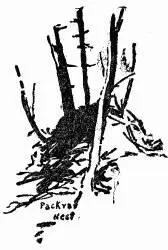 Pack-rat nest
Pack-rat nest
As you cross any of the level, well-grassed prairie regions in the Yellowstone you will see piles of soft earth thrown up in little hillocks, sometimes a score or more of them bunched together. The drivers will tell you that these are molehills, which isn't quite true. For the Mole is a creature unknown in the Park, and the animal that makes these mounds is exceedingly abundant. It is the common Mole-gopher, a gopher related very distantly to the Prairie-dog and Mountain Whistler, but living the underground life of a Mole, though not even in the same order as that interesting miner, for the Mole-gopher is a rodent (Order Rodentia ) and the Mole a bug-eater (Order Insectivora ); just as different as Lion and Caribou.
The Mole-gopher is about the size of a rat, but has a short tail and relatively immense forepaws and claws. It is indeed wonderfully developed as a digger.
Examine the mound of earth thrown up. If it is a fair example, it will make fully half a bushel. Next count the mounds that are within a radius of fifty paces; probably all are the work of this Gopher, or rather this pair, for they believe in team play.
Читать дальшеИнтервал:
Закладка:
Похожие книги на «Wild Animals at Home»
Представляем Вашему вниманию похожие книги на «Wild Animals at Home» списком для выбора. Мы отобрали схожую по названию и смыслу литературу в надежде предоставить читателям больше вариантов отыскать новые, интересные, ещё непрочитанные произведения.
Обсуждение, отзывы о книге «Wild Animals at Home» и просто собственные мнения читателей. Оставьте ваши комментарии, напишите, что Вы думаете о произведении, его смысле или главных героях. Укажите что конкретно понравилось, а что нет, и почему Вы так считаете.
